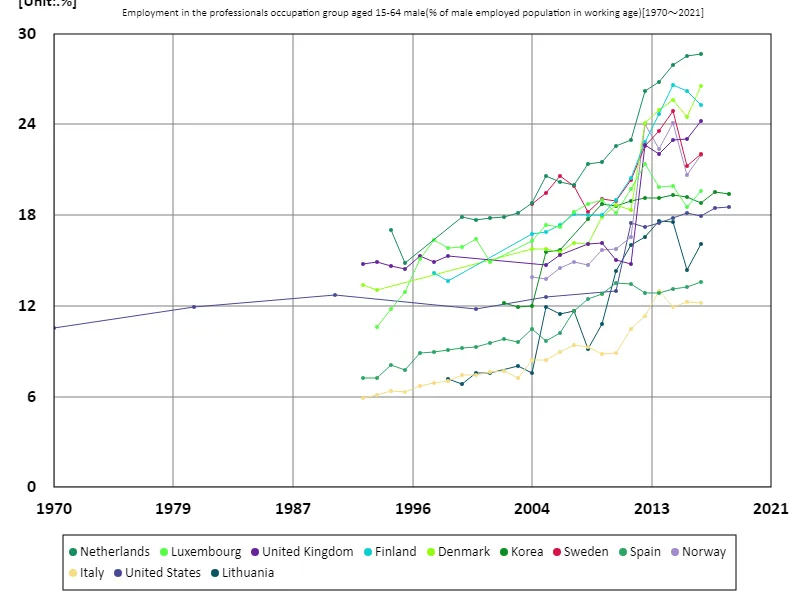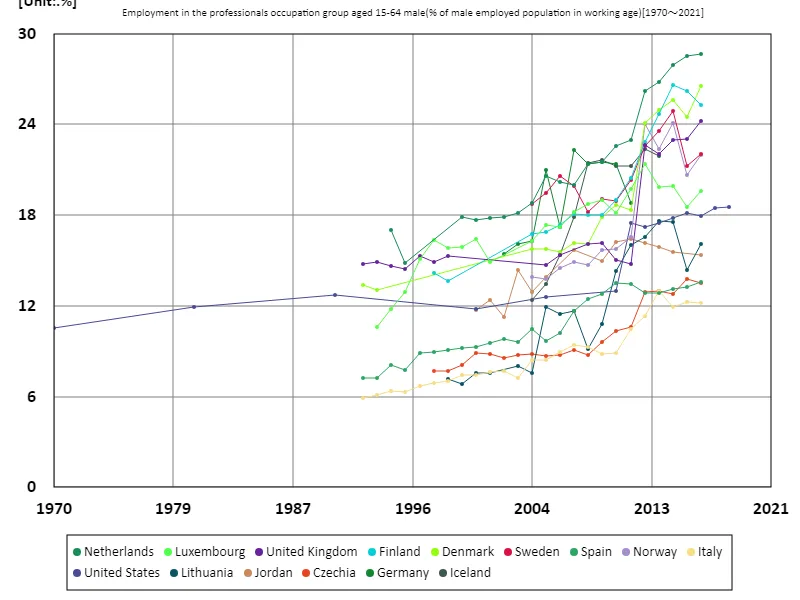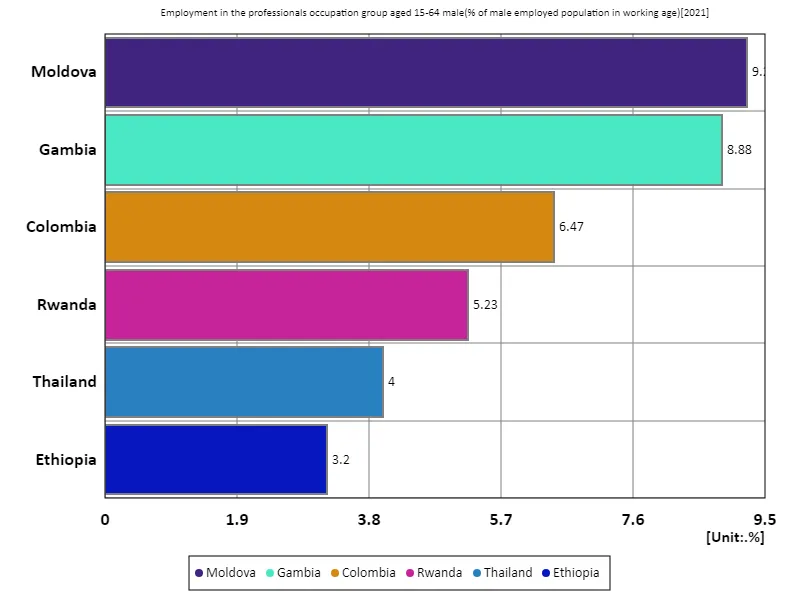- Abstract
- Employment rate for men aged 15-64 in the professional sector (percentage of working-age males in the workforce)
- Employment rate of professional occupations for men aged 15-64 (percentage of working-age male employed population) (Worldwide)
- Employment rate of professional occupations for men aged 15-64 (percentage of working-age males in the labour force) (world, latest year)
- Reference
Abstract
According to 2018 data, South Korea’s professional employment rate for men aged 15-64 was 19.4%, the highest in the world. This figure reflects the characteristics of South Korea’s economic structure and labor market. South Korea is a country with high demand for skilled workers due to its rapid industrial development and high level of education. The high employment rate in the professional sector indicates robust growth, particularly in the areas of technological innovation and research and development, which underpins Korea’s economic competitiveness. In contrast, employment rates in the professional sector are lower in many other countries, reflecting differences in education systems, industrial structures and labour market maturity. South Korea’s high employment rate in professional occupations is also linked to the development of its education system and the increasing demand for specialized skills, but at the same time, problems such as overwork and stress are also cited.
Employment rate for men aged 15-64 in the professional sector (percentage of working-age males in the workforce)
Looking at data from 1970 to 2018, we see a notable change in the employment rate of professional occupations among men aged 15-64. In particular, the Netherlands recorded the world’s highest skilled employment rate in 2016 at 28.7%. This reflects the characteristics of the Dutch economic structure and labour market. The Netherlands has long had a high demand for skilled workers, especially in fields that require advanced skills and knowledge. The peak in employment in the Netherlands reflects the country’s shift towards higher value-added sectors of the economy and an increase in the share of jobs requiring highly specialized skills and knowledge. Furthermore, a flexible labour market and a well-developed education system also support this high employment rate. Data dating back to the 1970s shows that employment rates in the professional sector have risen gradually around the world, but few countries have shown such rapid increases as those in the Netherlands. The Netherlands’ high employment rate reflects policy and industry changes that have contributed to the growth of the profession, particularly the country’s strong investment in innovation and research and development, when compared to similar trends in other countries. However, an increase in professional occupations could lead to overwork and labor market imbalances, so improving working conditions will be a future challenge.


The maximum is the latest one, 28.7% of Netherlands
Employment rate of professional occupations for men aged 15-64 (percentage of working-age male employed population) (Worldwide)
Analysing data from 1970 to 2018, the employment rate in the professional sector for men aged 15-64 has undergone notable changes. In particular, the skilled employment rate recorded by the Netherlands in 2016 was 28.7%, the highest in the world. This peak marks a shift in the Netherlands towards occupations that require higher levels of specialised skills and knowledge, and shows that the country’s education system and labour market structure support this high employment rate. Looking at data going back to the 1970s, employment rates in the professional sector have been gradually increasing. This is due to the growing importance of technological innovation and the knowledge economy globally, which has led to an increased demand for workers with specialized skills. The Netherlands’ high employment rate reflects strong growth, particularly in the technology, research and development and services sectors. The Dutch peak employment rate of 100% is a relative comparison to the previous highest value and, although it remains the same in absolute terms, it represents sustained growth in the professional sector. This trend is particularly evident in comparison with other countries and highlights the high demand for advanced Dutch technology and expertise. However, as the number of specialized occupations increases, problems of labor market congestion and overwork may arise, and it will be necessary to create a balanced working environment in the future.


The maximum is the latest one, 28.7% of Netherlands
Employment rate of professional occupations for men aged 15-64 (percentage of working-age males in the labour force) (world, latest year)
According to 2021 data, Moldova has the highest employment rate in the professional sector for men aged 15-64 at 9.25%, compared to the global average of 6.17% and 37% in total. This trend indicates that the professional sector plays an important role in the global labour market. Moldova’s high employment rate in professional occupations is likely due to the country’s economic development, improving educational levels, and increasing demand for professional occupations. Over the past few decades, employment rates in the professional sector have risen gradually. This is because technological innovation and globalization have led to an increase in occupations that require more advanced specialized knowledge and skills. This trend is particularly noticeable in developed countries, where employment rates for professionals tend to be higher. However, many countries also have low employment rates for skilled workers, which may be due to a lack of developed educational institutions and technological infrastructure. The growth of the professional sector signals a shift in the economy towards knowledge-intensive industries, a trend that is expected to continue. However, as the number of professionals increases, issues such as labor market imbalances and overwork also need to be addressed.


The maximum is 9.25% of Moldova, the average is 6.17%, and the total is 37%



Comments